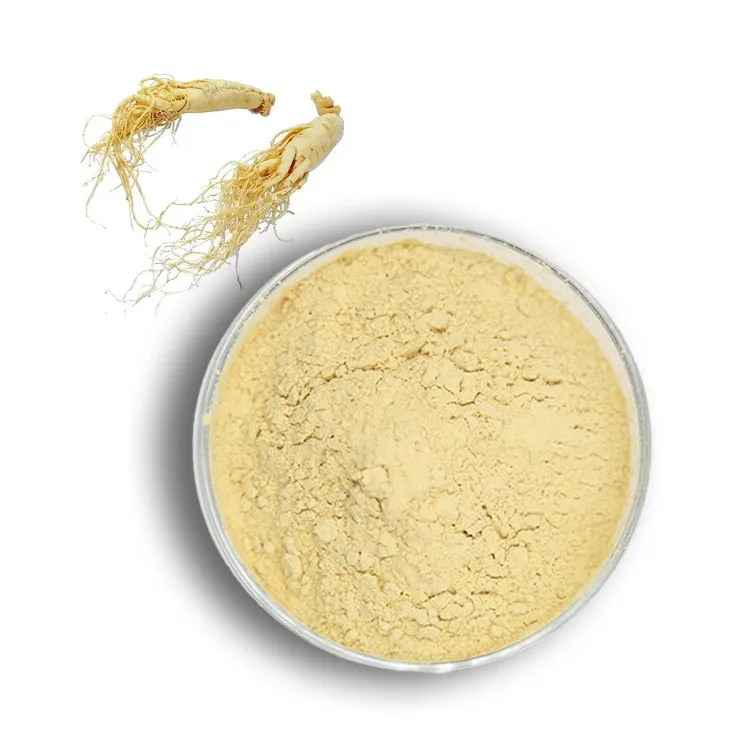- 0086-571-85302990
- sales@greenskybio.com
Supercritical carbon dioxide extraction of ginseng root extract.
2024-11-27

1. Introduction to Ginseng
Ginseng has been a highly regarded plant in traditional medicine for centuries. Native to Asia, especially in regions like China and Korea, it has also been found in North America. Ginseng roots are the main part used for medicinal purposes. They are believed to possess a wide range of therapeutic properties, such as enhancing the immune system, improving cognitive function, and increasing energy levels. These properties are attributed to the various bioactive compounds present in the ginseng roots, including ginsenosides, polysaccharides, and flavonoids.

2. The Significance of Extracting Ginseng Root Extract
2.1 Medicinal Applications
The extraction of Ginseng Root Extract is crucial for modern medicine. It allows for the isolation and concentration of the bioactive compounds, which can then be used in the development of pharmaceuticals. For example, ginsenosides have been studied for their potential in treating various diseases, such as diabetes, cardiovascular diseases, and cancer. By extracting the root extract, these compounds can be more effectively utilized in drug research and development.
2.2 Nutraceutical and Cosmetic Use
In the nutraceutical industry, Ginseng Root Extract is a popular ingredient. It is added to dietary supplements to provide health benefits to consumers. In cosmetics, it is used for its antioxidant and anti - aging properties. Extracting the root extract in a pure and efficient manner is essential to ensure the quality of these products.

3. Supercritical Carbon Dioxide: An Ideal Solvent
3.1 Properties of Supercritical Carbon Dioxide
Supercritical carbon dioxide (CO₂) has unique properties in its supercritical state. It has a density similar to that of a liquid, which allows it to dissolve many substances effectively. At the same time, it has a viscosity close to that of a gas, which enables it to penetrate into the pores of the ginseng roots easily. Moreover, supercritical CO₂ has a low surface tension, which aids in the extraction process.
3.2 Advantages over Traditional Solvents
- Non - Toxic and Non - Flammable: Unlike some traditional solvents such as chloroform or methanol, supercritical CO₂ is non - toxic and non - flammable. This makes the extraction process much safer, reducing the risk of environmental pollution and workplace hazards.
- Easily Removable: After the extraction process, supercritical CO₂ can be easily removed from the extract by simply reducing the pressure. This leaves behind a pure extract without any solvent residues, which is highly desirable for pharmaceutical and food applications.
- High Selectivity: Supercritical CO₂ can be adjusted to have different solubilities for different compounds. This means that it can selectively extract the desired bioactive compounds from ginseng roots while leaving behind unwanted substances, resulting in a higher - quality extract.

4. The Supercritical Carbon Dioxide Extraction Process
4.1 Pretreatment of Ginseng Roots
Before the extraction, ginseng roots need to be properly pretreated. This usually involves cleaning the roots to remove dirt and impurities, followed by drying them to an appropriate moisture content. Sometimes, the roots may also be ground into a powder to increase the surface area for better extraction efficiency.
4.2 Extraction Parameters
- Pressure: The pressure is a crucial parameter in supercritical CO₂ extraction. Different bioactive compounds in ginseng roots may require different pressures for optimal extraction. Generally, pressures in the range of 10 - 50 MPa are often used.
- Temperature: Temperature also affects the solubility of compounds in supercritical CO₂. Temperatures typically range from 35 - 60 °C. Higher temperatures may increase the solubility but may also cause degradation of some heat - sensitive compounds.
- Flow Rate of CO₂: The flow rate of supercritical CO₂ determines how quickly the extraction occurs. A higher flow rate may lead to faster extraction but may also require more energy and CO₂ consumption.
- Extraction Time: The extraction time needs to be optimized. Too short an extraction time may result in incomplete extraction of the bioactive compounds, while too long a time may lead to the extraction of unwanted substances or degradation of the desired compounds.
4.3 Separation and Collection of the Extract
After the extraction, the supercritical CO₂ containing the dissolved bioactive compounds is separated from the ginseng roots. This is usually achieved by reducing the pressure, which causes the CO₂ to return to its gaseous state and the extract to be collected. The collected extract may then be further processed, such as purification or formulation, depending on its intended use.

5. Quality Control in Supercritical Carbon Dioxide Extraction
5.1 Analysis of Bioactive Compounds
To ensure the quality of the ginseng root extract, it is necessary to analyze the content of bioactive compounds. This can be done using various analytical techniques, such as high - performance liquid chromatography (HPLC) for the quantification of ginsenosides, and spectrophotometric methods for the determination of polysaccharides. By monitoring the levels of these compounds, the extraction process can be adjusted to ensure consistent quality.
5.2 Purity and Residue Testing
Testing for the purity of the extract is essential. This includes checking for the presence of any contaminants or impurities, such as heavy metals or residual solvents. Supercritical CO₂ extraction is known for its ability to produce solvent - free extracts, but it is still necessary to verify this through appropriate testing methods. Residue testing can ensure that the extract meets the strict requirements for pharmaceutical, food, and cosmetic applications.

6. Commercial Potential of Supercritical Carbon Dioxide - Extracted Ginseng Root Extract
6.1 Pharmaceutical Industry
The pharmaceutical industry is constantly seeking high - quality natural products for drug development. Supercritical CO₂ - extracted ginseng root extract, with its high purity and controlled composition of bioactive compounds, has great potential in this area. It can be used as a raw material for the development of new drugs or as an ingredient in existing pharmaceutical formulations.
6.2 Nutraceutical and Dietary Supplement Market
The nutraceutical and dietary supplement market is growing rapidly, and consumers are increasingly demanding high - quality products. Ginseng root extract obtained through supercritical CO₂ extraction can meet these demands. Its clean label (due to the absence of solvent residues) and high bioactivity make it an attractive ingredient for dietary supplements.
6.3 Cosmetic Industry
In the cosmetic industry, natural and effective ingredients are highly sought after. Ginseng root extract has antioxidant and anti - aging properties that are beneficial for skin health. Supercritical CO₂ - extracted ginseng root extract can be incorporated into various cosmetic products, such as creams, lotions, and serums, to enhance their functionality.
7. Challenges and Future Perspectives
7.1 High - Cost Equipment
The equipment required for supercritical CO₂ extraction is relatively expensive. This includes high - pressure pumps, extraction vessels, and separation systems. The high cost of equipment can be a barrier for small - scale producers or research institutions. However, as the technology becomes more widespread, the cost may gradually decrease through economies of scale.
7.2 Optimization of Extraction Parameters
Although there are general guidelines for extraction parameters, further research is needed to optimize these parameters for different varieties of ginseng and different bioactive compounds. This requires more in - depth understanding of the interactions between supercritical CO₂ and the compounds in ginseng roots.
7.3 Regulatory Considerations
As with any new extraction technology, there are regulatory challenges. The regulatory authorities need to develop appropriate standards and guidelines for the production and use of supercritical CO₂ - extracted ginseng root extract. This includes setting limits for impurities, ensuring the safety of the extract, and validating the extraction process.
Despite these challenges, the future of supercritical carbon dioxide extraction of ginseng root extract looks promising. With continued research and development, this technology has the potential to revolutionize the production of high - quality ginseng root extract for various industries.
FAQ:
What are the advantages of using supercritical carbon dioxide for ginseng root extract extraction?
Supercritical carbon dioxide has several advantages for ginseng root extract extraction. Firstly, it can extract bioactive compounds with high efficiency and purity. Secondly, the extraction process is highly controllable, enabling the optimization of extraction parameters to obtain high - quality extract. Also, it is non - toxic and non - flammable, which is safer compared to some traditional extraction methods.
How does supercritical carbon dioxide extract bioactive compounds from ginseng roots?
In the supercritical state, carbon dioxide has unique properties that allow it to act as an ideal solvent. It can penetrate the ginseng root matrix and selectively dissolve the bioactive compounds, thus achieving the extraction process.
What are the main bioactive compounds in ginseng root extract?
Ginseng root extract contains various bioactive compounds such as ginsenosides, polysaccharides, and flavonoids. These compounds are responsible for the medicinal properties associated with ginseng.
Is supercritical carbon dioxide extraction cost - effective for ginseng root extract?
Although the initial investment for supercritical carbon dioxide extraction equipment may be relatively high, in the long run, it can be cost - effective. This is because it can produce high - quality extract efficiently, reducing waste and potentially increasing the market value of the final product. Also, the safety aspects can save on additional safety - related costs compared to some traditional extraction methods.
How does supercritical carbon dioxide extraction compare with traditional extraction methods for ginseng root extract?
Compared to traditional extraction methods, supercritical carbon dioxide extraction is safer as it is non - toxic and non - flammable. It also offers higher efficiency and purity in extracting bioactive compounds. Traditional methods may use solvents that are more difficult to remove completely, while supercritical carbon dioxide can be easily removed from the extract, leaving a cleaner product.
Related literature
- Supercritical Fluid Extraction of Bioactive Compounds from Ginseng"
- "Optimization of Supercritical Carbon Dioxide Extraction of Ginseng Root"
- "Advances in Supercritical CO₂ Extraction of Medicinal Plant Extracts with a Focus on Ginseng"
- ▶ Hesperidin
- ▶ Citrus Bioflavonoids
- ▶ Plant Extract
- ▶ lycopene
- ▶ Diosmin
- ▶ Grape seed extract
- ▶ Sea buckthorn Juice Powder
- ▶ Fruit Juice Powder
- ▶ Hops Extract
- ▶ Artichoke Extract
- ▶ Mushroom extract
- ▶ Astaxanthin
- ▶ Green Tea Extract
- ▶ Curcumin
- ▶ Horse Chestnut Extract
- ▶ Other Product
- ▶ Boswellia Serrata Extract
- ▶ Resveratrol
- ▶ Marigold Extract
- ▶ Grape Leaf Extract
- ▶ New Product
- ▶ Aminolevulinic acid
- ▶ Cranberry Extract
- ▶ Red Yeast Rice
- ▶ Red Wine Extract
-
Soy Extract
2024-11-27
-
Baicalin
2024-11-27
-
Apricot Powder
2024-11-27
-
Bitter Melon Extract
2024-11-27
-
Feverfew Extract
2024-11-27
-
Peppermint Extract Powder
2024-11-27
-
Grape Seed Extract
2024-11-27
-
Aminolevulinic acid
2024-11-27
-
Coconut Water Powder
2024-11-27
-
Camu Camu Extract
2024-11-27





















